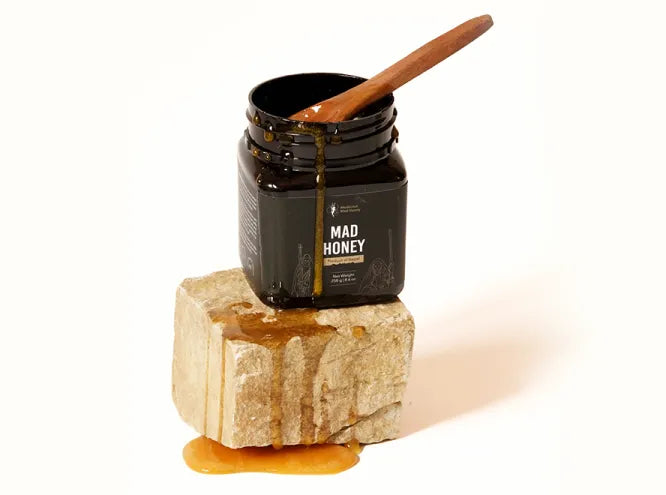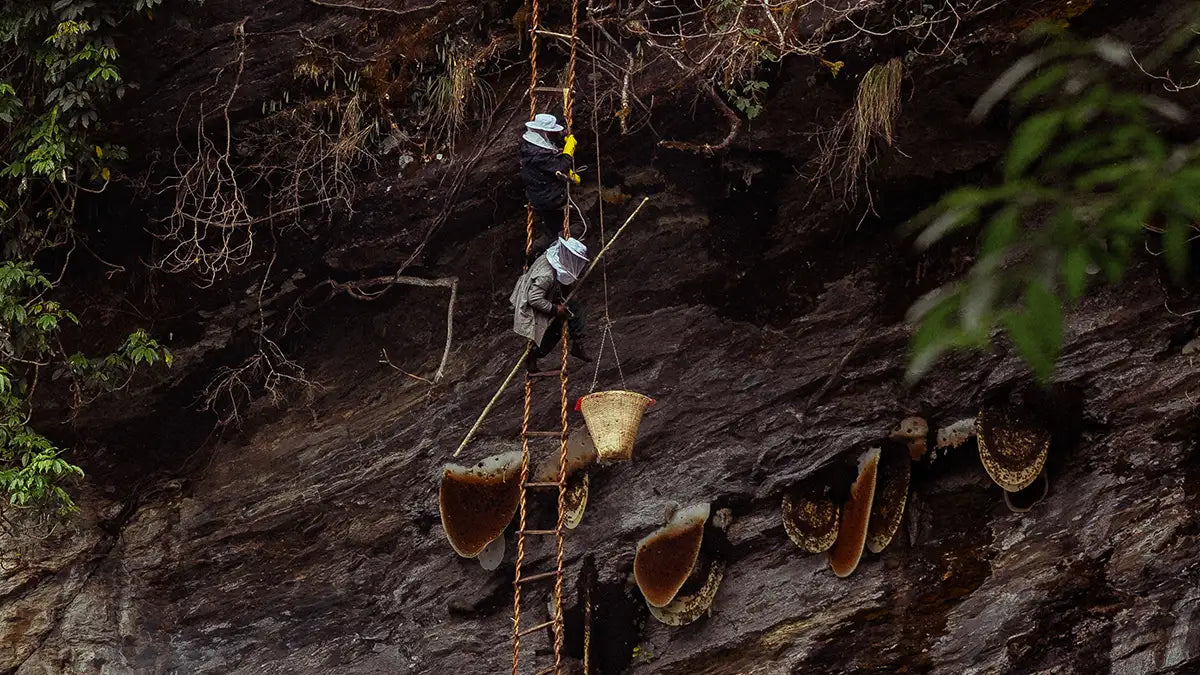Mad Honey Hunting, an activity that dates back centuries, has been part of people’s histories in such a manner that it is entwined with their cultures. From its ancient roots to modern livelihood, mad honey hunting has fascinated many minds. Nevertheless, a few individuals talk about the tools and equipment used in honey hunting. Such tools are essential aspects of mad honey hunting that need to be acknowledged. In our blog, we bring forward those tools and equipment that have shaped the art of honey hunting as we peel back the layers of this ancient tradition.
Early Days of Mad Honey-Hunting

The tradition of mad honey hunting goes back to around 8,000 BC. Although it is just starting to be recognized now, the past of this practice is very long and remarkable. About five years ago, a whole article about honey-hunting communities was published by National Geographic. Similarly, Vice and many other media portals wrote articles or uploaded videos on the very mad honey and its process. That is how the fame of mad honey rose worldwide.
People used to hunt honey to as a part of their tradition during ancient times. However, this tradition has evolved into a livelihood for many, providing sustenance for individuals and their families. So, what exactly is mad honey hunting? You may know about Mad Honey and its side effects. But do you know about its alluring beginning? Where was it first found? And who first used it? It’s all a fascinating anecdote when it comes to the history of mad honey.
Explore more about the ancient history of Mad Honey.
Mad Honey- Hunting in Nepal

Mad Honey hunting is a daring job undertaken by honey hunters twice a year. The Apis Laboriosa is an enormous honeybee that collects nectar from rhododendron flowers. This nectar contains grayanotoxin, a special ingredient that causes hallucinations in one's body. Hallucinations may vary from person to person according to their body type.
After collecting the nectar, these wild bees make their hives on cliffs hidden from the world. So, the honey collected by these bees is known as mad honey. To collect this mysterious mad honey from nepal, a honey hunter is chosen who will climb up the rope ladder and collect the mad honey. And the other honey hunters will assist him in the collection process. So, honey hunting requires teamwork based on solidarity among everyone who participates.
Equipment required for Mad honey hunting
The honey hunter uses various tools and equipment while hunting for mad honey. There are a few hunters who have shifted to modern equipment for honey hunting. However, a large number of them are still using ancient tools. Most of the tools used for honey hunting are made of bamboo. Some main essential tools are:
(Uab) Bamboo rope
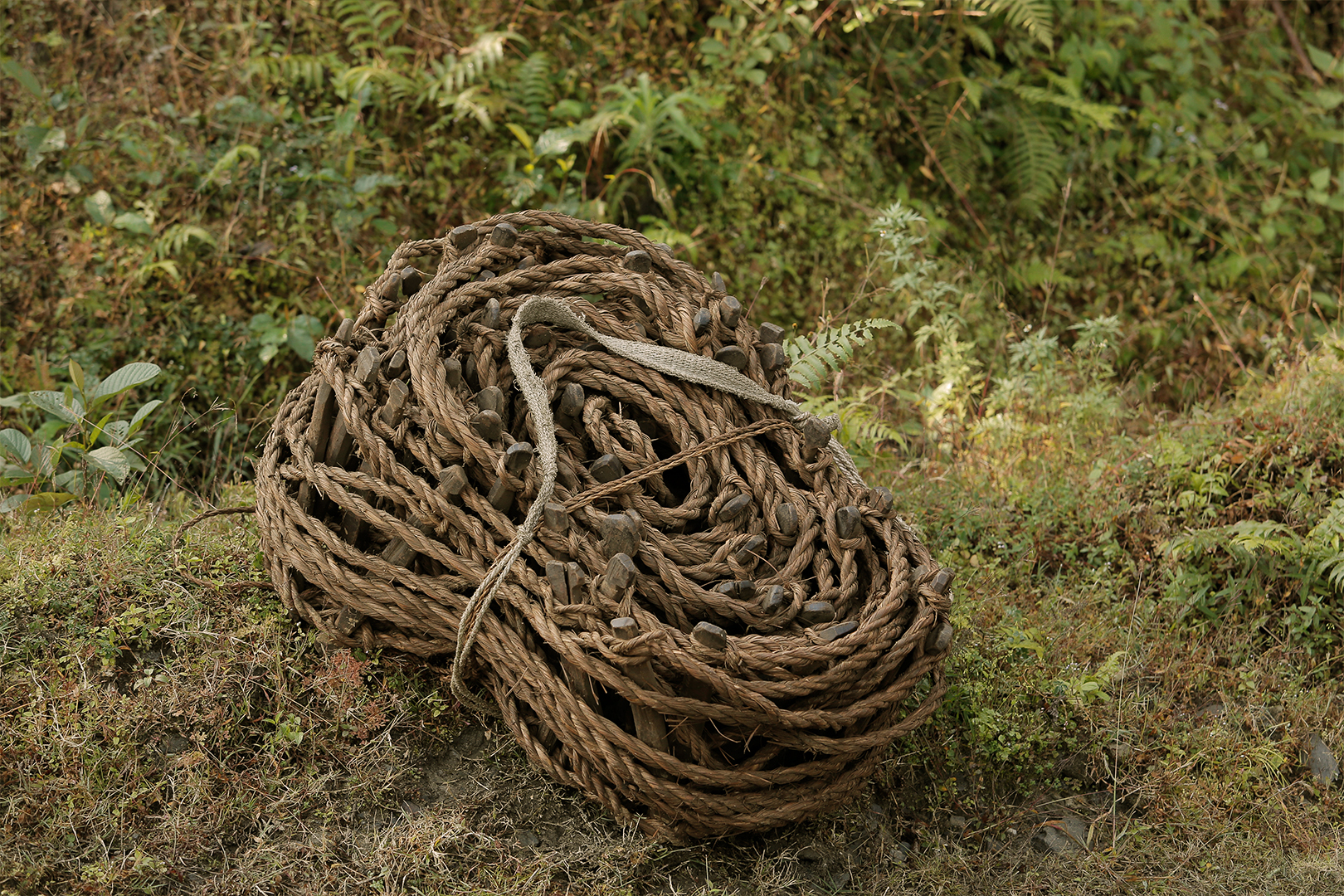
The rope is a crucial tool used in honey hunting to tie the rope ladder to the tree trunk. It is made of bamboo fibers and is known for its strength, flexibility and resistance. The simplest way to make it is by twisting bamboo strips together. The rope holds the rope ladder in place as it rests on top of the tree ensuring that honey hunters can climb and descend safely from great heights.
(Prang) Bamboo ladder
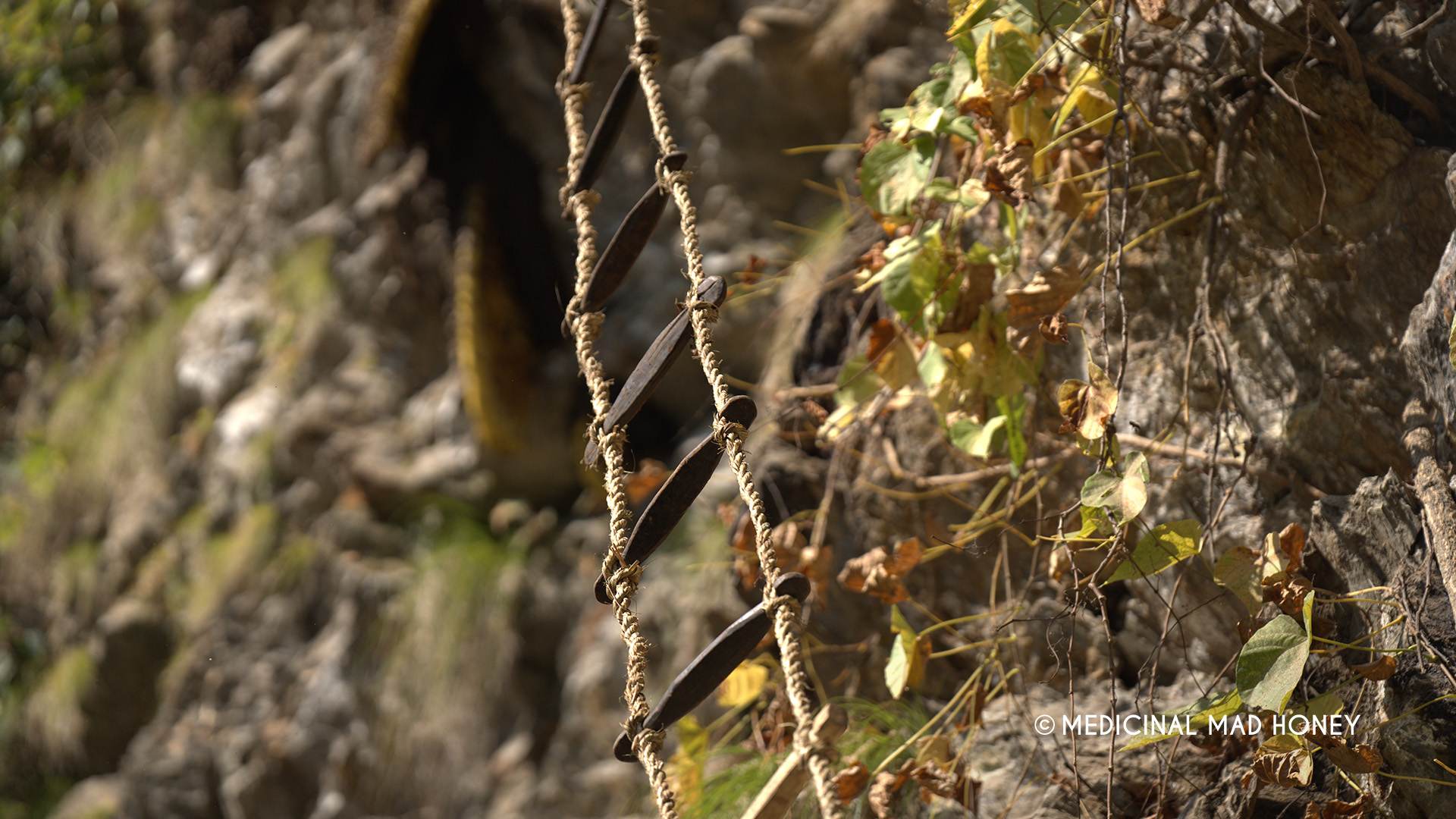
It is made by combining bamboo rope and ladders. The rope is made from bamboo fiber and the steps are wooden planks. The honey hunter needs this ladder to reach the mad honey’s hive since its structure allows one to reach extreme altitudes. The bamboo ladder is strong and light enough for easy movement across challenging landscapes.
(Saaton) Stick:
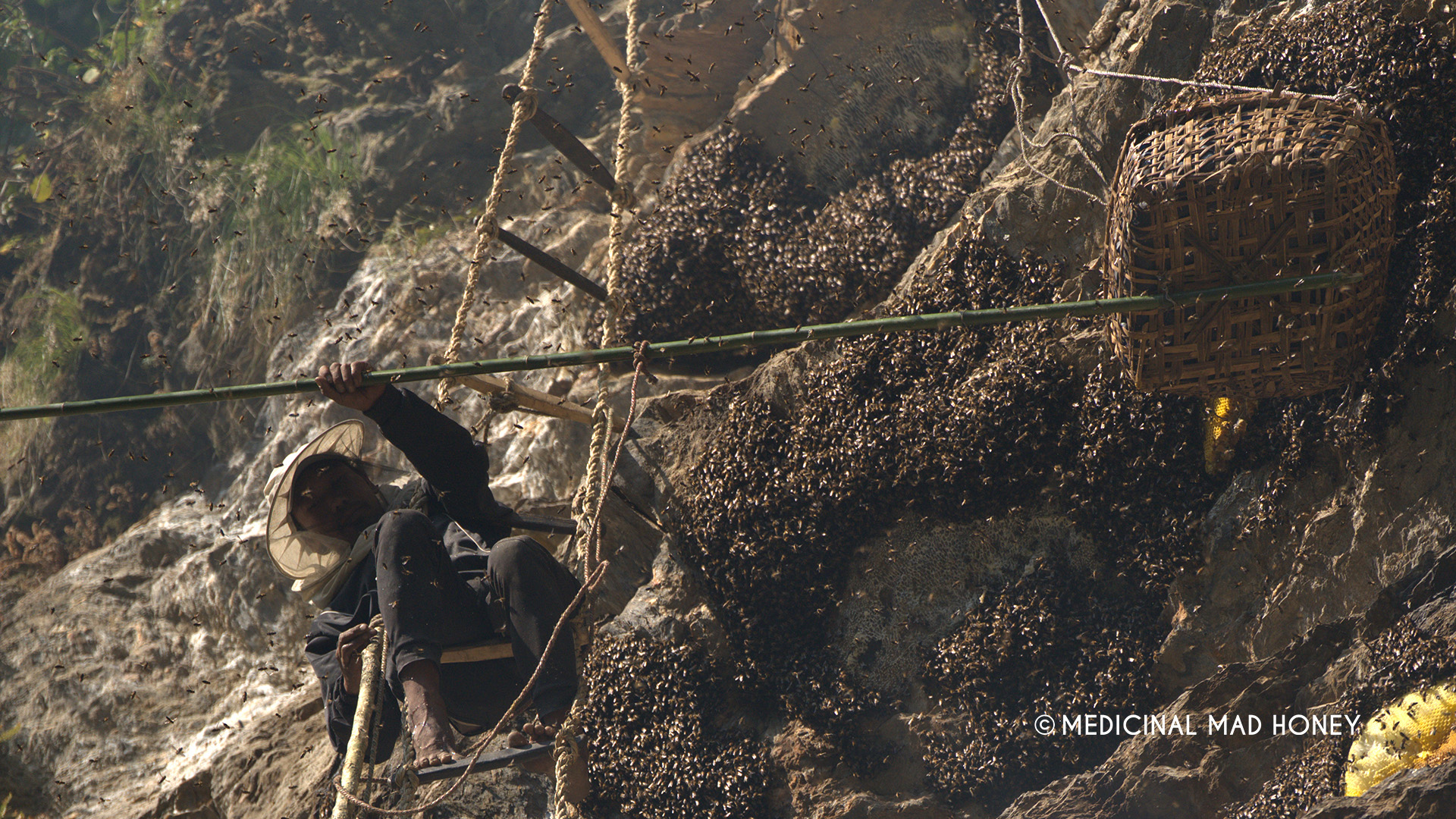
This stick has two sharp ends and a plain surface at the center. It helps to attach ropes during honey hunting expeditions. The bamboo stick is used to guide the hook in honey hunting. Saaton stick length can be adjusted to match the distance needed for honey harvesting.
(Tango/Ghochma) Stick
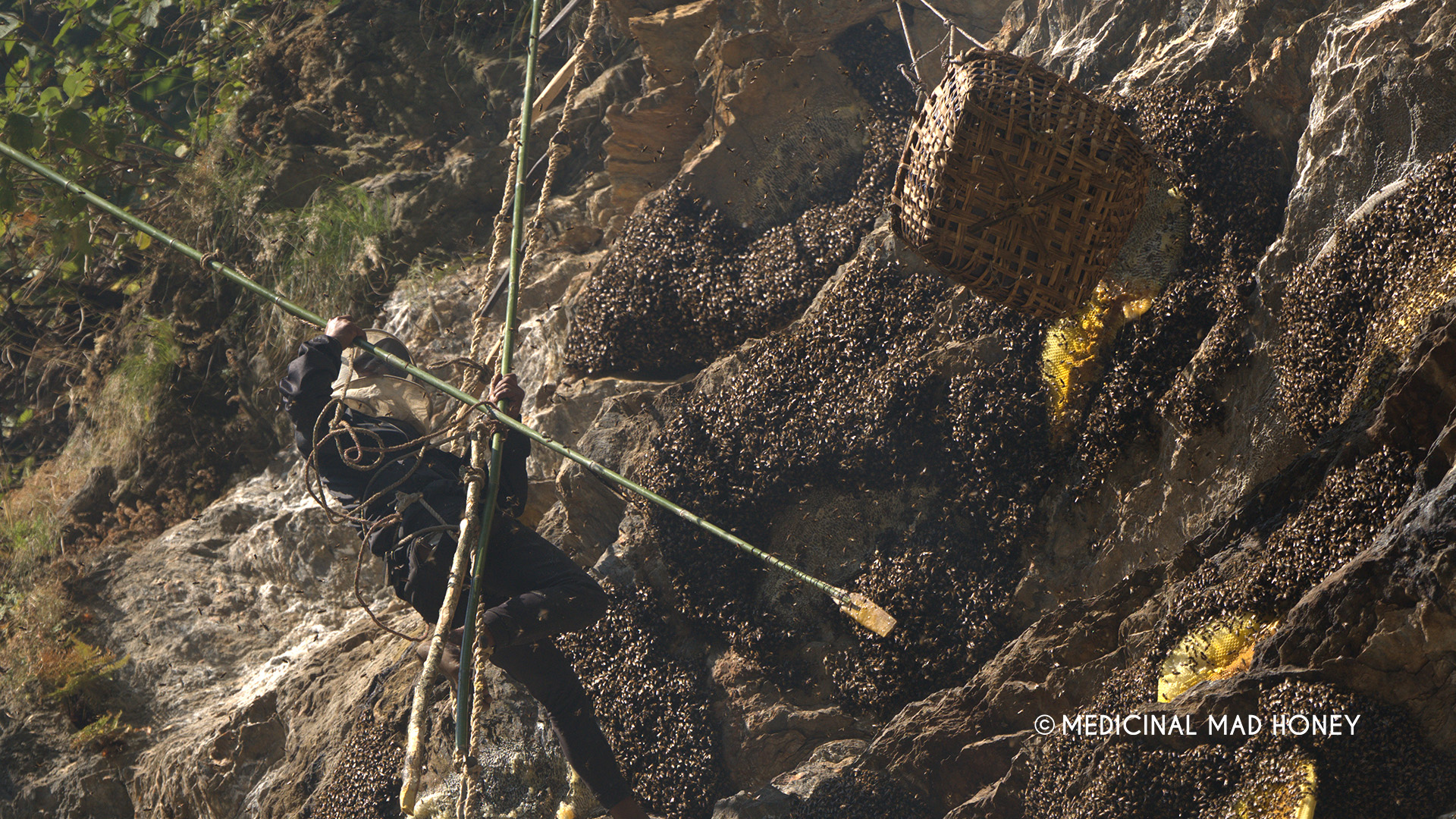
This stick has a wooden blade attached to the end of the bamboo stick. It helps to cut the honeycomb into bamboo baskets. The bamboo stick is used to guide the wooden blade in hallucinogenic honey hunting. One can adjust the length of the tango stick to match the overall length needed for honey hunting.
(Koili chho) Rope with a hook
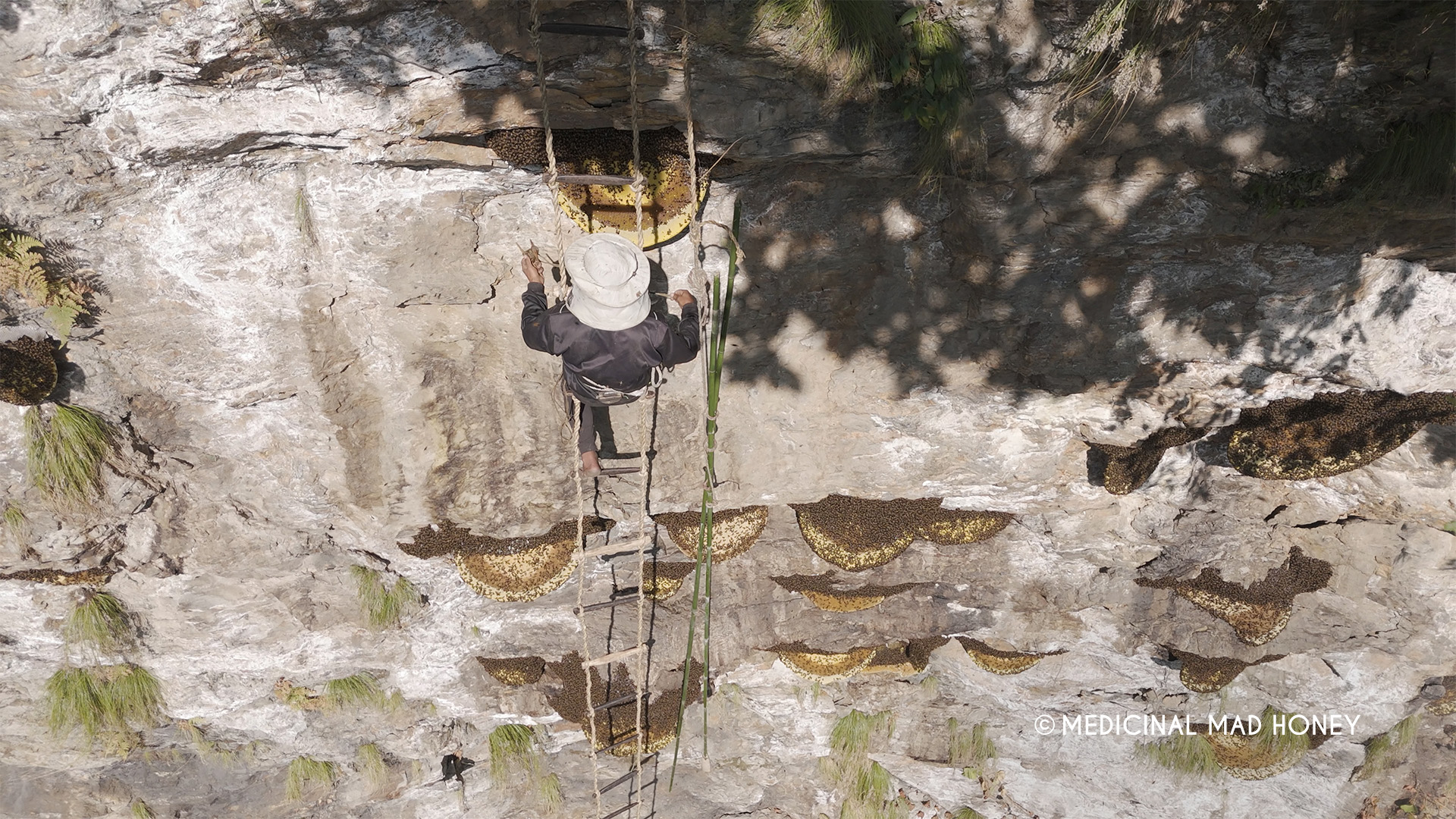
This tool is made of locally available fiber materials and features a hook attached to the end rope. It is an important tool for separating the brood honeycomb from the hive which can be a delicate operation that requires both patience and care. The hook enables the honey hunter to detach the brood gently so as not to disrupt the hive even if they take the honey. With this tool, gathering mad honey becomes easier. Thus, it not only saves time but also increases efficiency.
(Tokari) Bamboo basket:
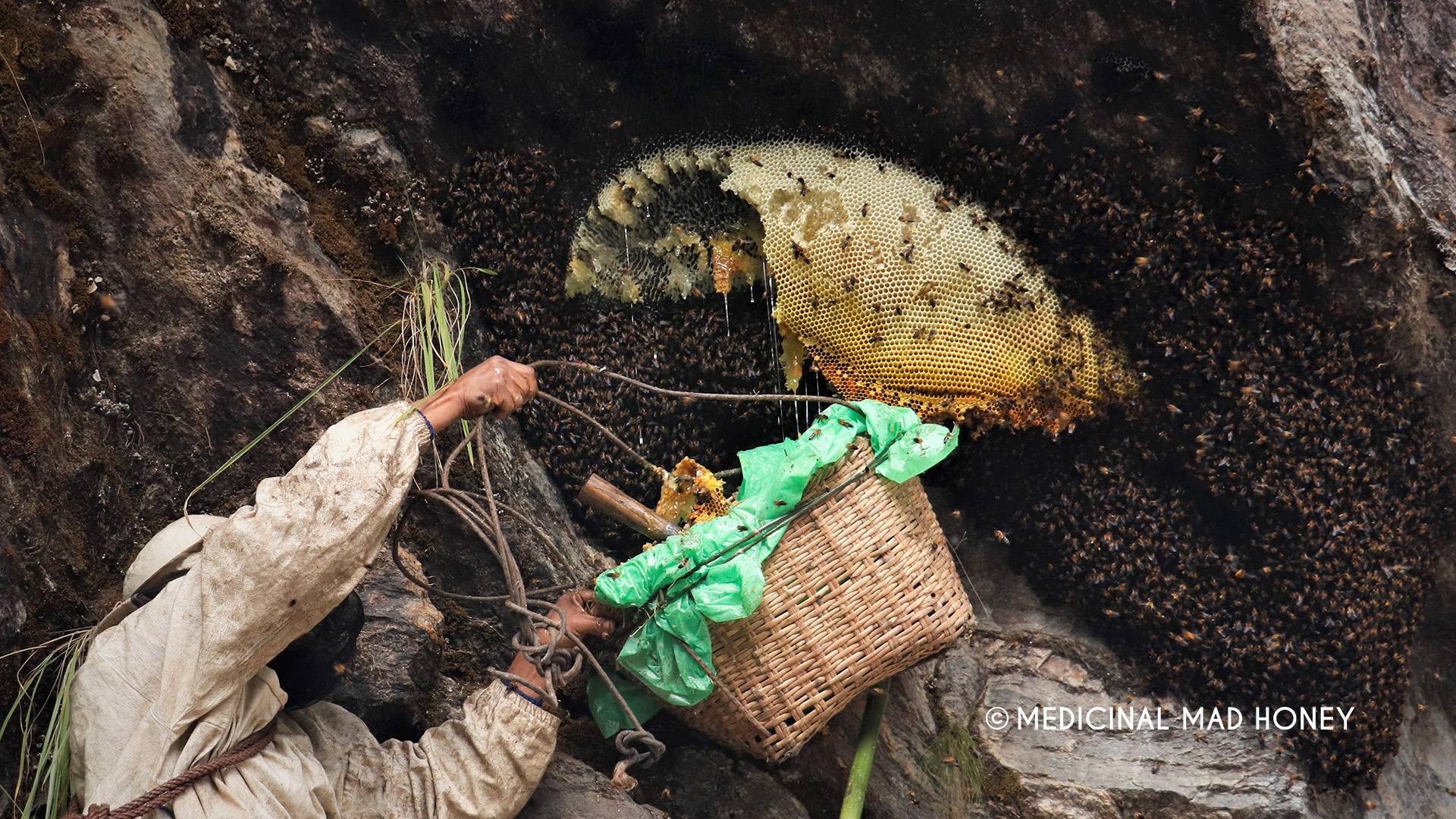
It is a typical container for gathering mad honey that has been harvested. It is carefully crafted from strips of bamboo that are well woven together, hence making this basket strong yet light enough for carrying through dense forests. The design of the Tokari makes it easy to transport as well as store honey while ensuring its safety throughout the journey back to the village.
(Chhora) Filter:
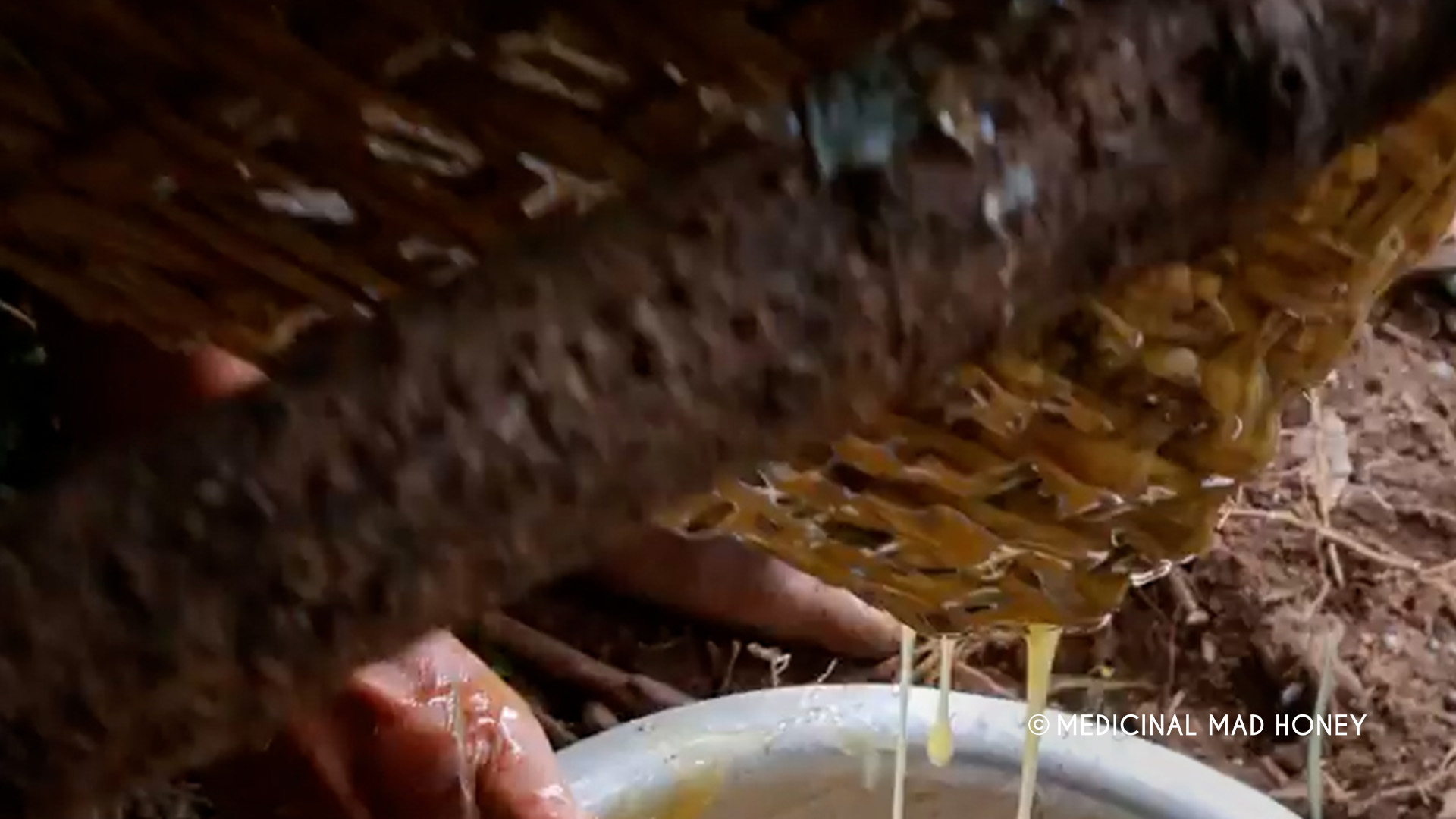
It is a filter made from bamboo cortex intended to strain and purify mad honey. This equipment helps in getting rid of the impurities of Mad Honey. It shows how closely linked honey hunting practices and the environment are through bamboo cortex being used in making it not only maintain quality but also make use of environmentally friendly materials.
Honey Hunting Technique
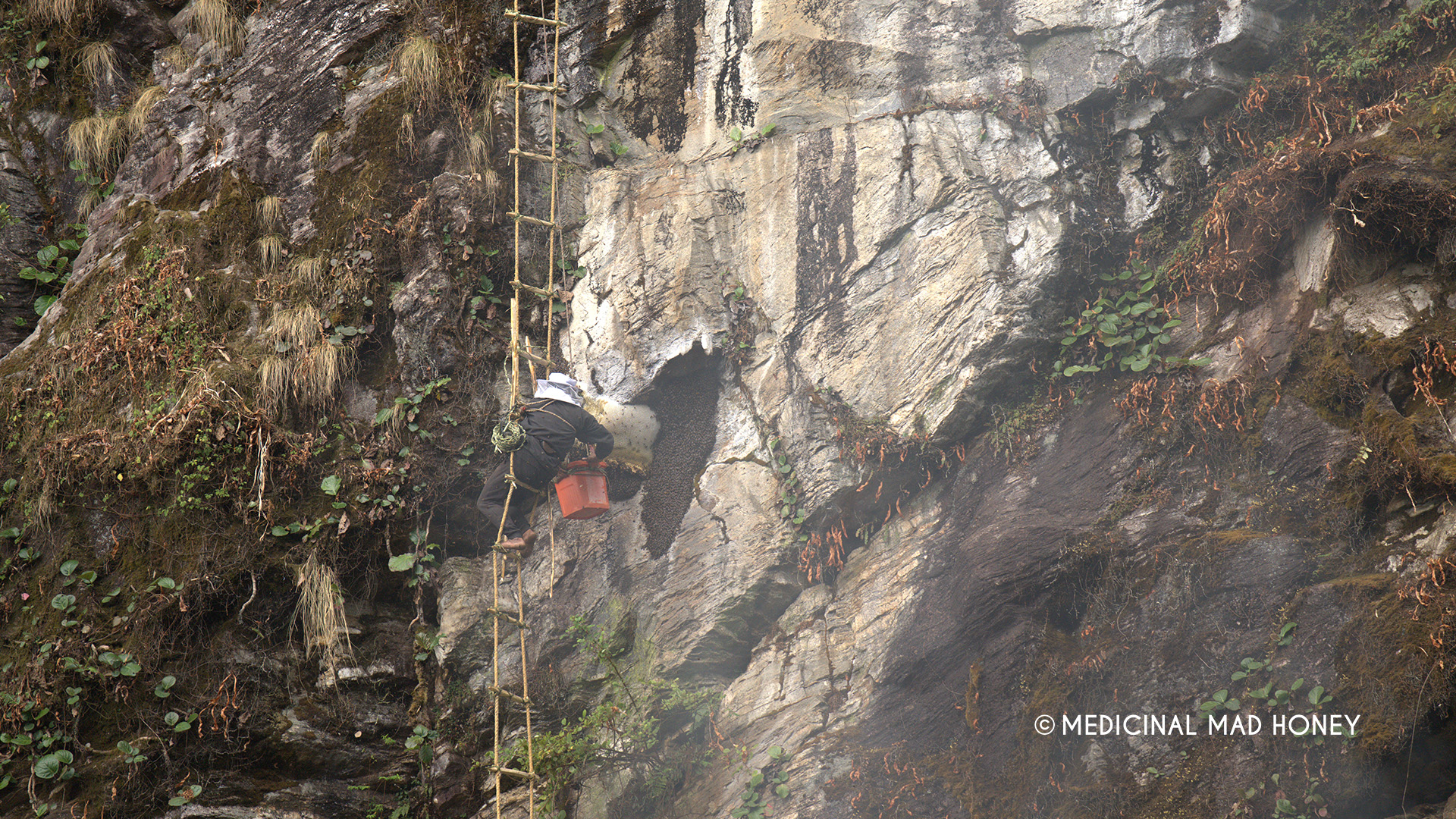
The Chosen honey hunter climbs up the stiff cliffs with a rope ladder (parang) while the other ties the bamboo sticks and bamboo basket (tokari) with the bamboo rope (uab) and passes it to the honey hunter. Then he grabs the rope with a hook (Koili chho) and places it in the honeycomb and with the bamboo stick with a wooden plate, he cuts the brood portion of the honeycomb. And the brood portion of the honeycomb comes down through the rope. Fun Fact: the brood portion of the honeycomb is not mad honey, it is simply beeswax.
After that, he grabs Saaton's stick and attaches it to the rope of the bamboo basket. Then, using his toe fingers, he grips the bamboo stick and balances himself on top of it to ensure its position right below the bee hives. With another bamboo stick (tango), the hunters skillfully slice through the mad honey right into the bamboo basket.
When the honey is collected, the other honey hunters with Filter (chhora) get rid of the impurities of Mad Honey. This process demands incredible balance, skill and bravery as they work at extremes to gather this exotic honey.
Modern Tools and Equipment
In recent years, technological advancements and safety measures have influenced the tools and equipment used in mad honey hunting. In some places, we can see people using plastic ropes and buckets as well as proper beekeeping gear for honey hunting. These tools help to mitigate risks faced by this group of hunters.
However, the other honey hunters feel otherwise. One of the honey hunters stated during our recent interview: “The rope available in the market nowadays may be stronger than the bamboo shoots rope, but they are not as durable as the rope made out of bamboo shoots. These bamboo ropes are very trustworthy and reliable for us.”
Maintenance and Care of Tools
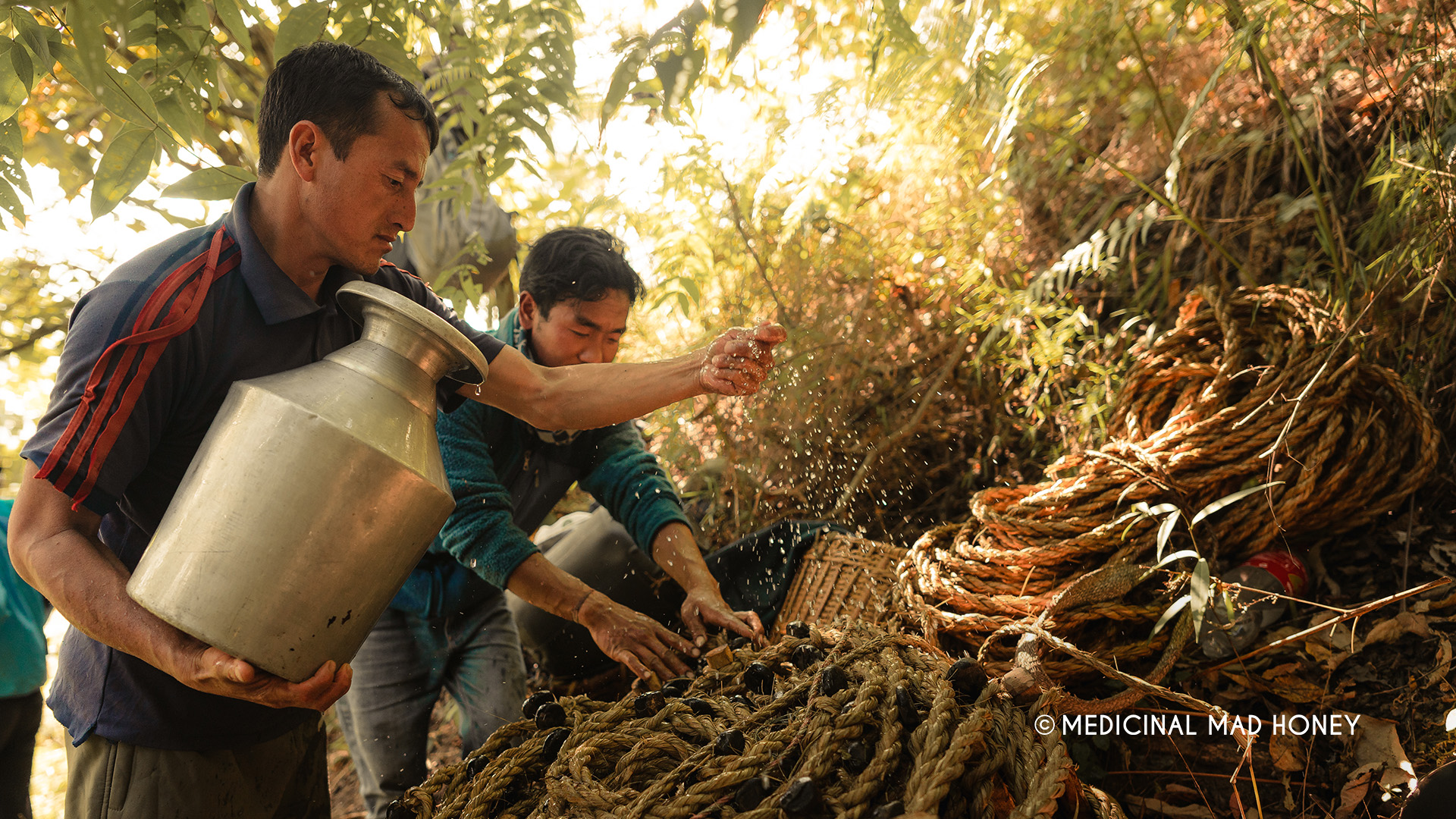
As we know, the tools and equipment are essential in Honey-hunting. So, that also means we must take good care of our tools and equipment. There are various ways to ensure the longevity of our tools and equipment:
- Reusing Tools: Since honey hunters invest so much effort in making tools, we manage to reuse those tools multiple times. These can be used for several honey hunts until they are functional, reflecting the skillfulness and strength of the tools.
- Revive Tools: When previous batches of rope are used in present-day honey hunting, the honey hunters soak the rope in water to decrease their stiffness and increase flexibility. These ropes, therefore, get rejuvenated to be used in the next honey-hunting expedition.
- Proper Storage: At the end of the honey hunt, hunters store it in a cool and dry place. The honey hunters take good care of their tools for future use. Taking these steps to care for our tools and equipment prolongs their lifespan. It respects the craftsmanship and effort that goes into creating them.
Conclusion
As the tradition of psychedelic honey hunting continues to evolve, the tools and equipment used reflect a delicate balance between tradition and modernization. While some honey hunters have embraced modern advancements for safety and efficiency, however, a significant number still believe in using old-fashioned bamboo equipment that has been effective in the past. The tools and techniques used by honey hunters reflect a deep-rooted tradition while also showing their adaptability and resourcefulness.
FAQs:
What are the tools used in honey harvesting?
Honey harvesting tools include a smoker, hive tool, bee brush, uncapping knife, extractor, and protective gear. These tools ensure safe collection without harming bees or damaging combs.
How do they harvest mad honey?
Mad honey is harvested by Gurung hunters who climb cliffs using bamboo ladders and ropes. They burn smoke to distract bees, then cut the honeycombs into baskets.
Which Nepalese town is known for honey hunting?
Kaski district, particularly villages near Lamjung and Annapurna regions, is renowned for traditional honey hunting by the Gurung community.
Who are the honey hunters of Nepal?
The Gurung people of central Nepal are famous honey hunters. They practice cliff honey hunting, a centuries-old tradition involving high-risk techniques.
What are honey tools?
Honey tools are equipment used in beekeeping, such as smokers, hive tools, extractors, and brushes, designed to harvest honey safely and efficiently.
What instruments are used in honey harvesting?
Instruments include protective clothing, smokers, hive tools, bee brushes, uncapping knives, and honey extractors. These ensure bee safety and quality honey collection.
